Inspired by the vast and majestic landscapes of the American West, Edmund “Ed” Mell’s paintings are monumental — some measuring as much as 8 by 12 feet. Square-shouldered buttes. Ancient cliffs. Deep gorges. Soaring sandstone spires. Above it all, an arch of deep blue sky — sometimes quiet, sometimes piled high with menacing clouds. Sometimes the striated clouds produce ferocious thunderstorms bristling with lightning that slashes across the darkening heavens. These violent-but-short cloudbursts are often followed by tranquil vermilion sunsets, nature’s benediction. “There’s something about the desert sky that is magical,” says Mell. “You can get lost in it.”
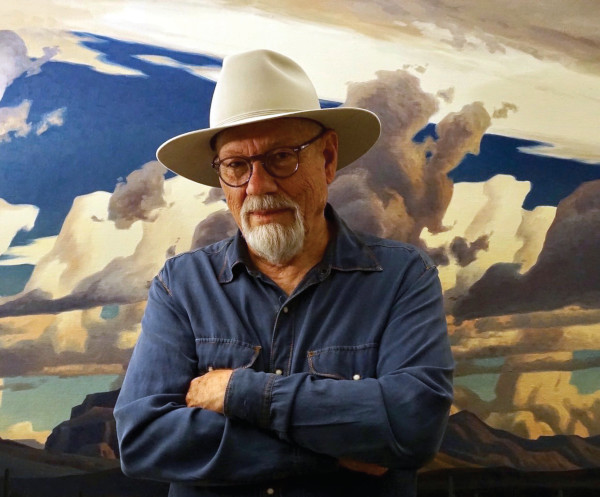
According to Mell, his love of this austere land truly began in the summer of 1970 when he took a break from his job as junior art director at Young and Rubicam, one of the top advertising agencies in New York, to direct a summer art program on the Hopi reservation. “It was complete culture shock … going straight from New York City to the tiny village of Hotevilla (then population 200) atop the windswept Third Mesa in northern Arizona,” he says. When not teaching, he hopped on a motorcycle and explored the surrounding high desert. “By the end of the summer, it was apparent to me that it was less about what I could teach … than what I could learn from the beauty of the land and the spiritual Hopi people,” he says. The following summer, he returned to teach a summer program on the Hopi reservation again.
At the end of each idyllic summer, Mell returned to New York, where he worked on major advertising campaigns for such clients as TWA, Air France, and Helena Rubenstein, as well as commissions to create illustrations for magazines as disparate as Esquire and National Lampoon.
“It was an exciting time,” he recalls, “but the dream was not quite there for me.” The call of the West was strong and persistent. Angular mountains and towering clouds swirled in his mind. He missed the wide-open spaces and the sense of freedom. “High rises are hard,” he says. “Life, for me … was meant to be lived closer to the land.”
In 1973, he packed his belongings into his 1962 Monza Coupe and made a break for the West — ultimately returning to his roots in Phoenix, Arizona, where his family settled in the 1920s and where he was born in 1942. He found work as a freelance illustrator, but at that time Phoenix was largely a cattle and cotton town and the market for commercial illustrators was very small. “My income was cut by a third, but my quality of life tripled,” he says with a grin. “And I learned that sometimes you have to leave a place and then come back to begin to appreciate it.”
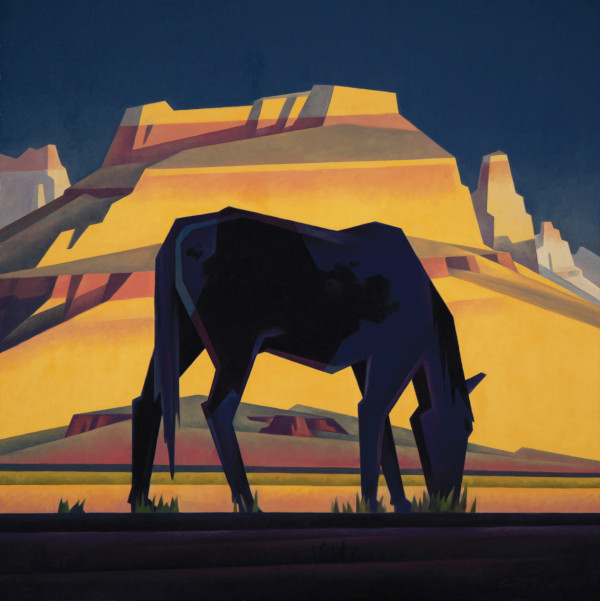
Once settled back in Arizona, he began painting large landscapes — mesas, canyons, and the horizon-to-horizon blue skies of the Sonoran Desert. His early paintings, like Twin Peaks in 1977, were minimal and modernist. “There’s a lot of power to this land,” he says. “I thought I could bring something new to the landscape that is often painted somewhat sentimentally.” As a commercial artist, he favored the sleek, linear forms of the art deco style. As a fine artist, he used many of the same design elements to capture the strength of turbulent sky and red-rock earth on canvas. Still, it was not until he had a sellout show in 1981 in Scottsdale, Arizona, that he realized he could make a living as a fine artist.
We caught up with Mell in his studio, a converted 1936 grocery store in the historic district of downtown Phoenix, where he is working on new oils to present at two shows scheduled for 2022. Inside the light-filled studio: tubes of oil paint in every imaginable hue, a massive array of brushes, cowboy memorabilia, Mexican prints, a collection of vintage toy cars, art books and photographs, and several drawings by noted American landscape painter Maynard Dixon who, along with the Taos Society of Artists, had the biggest impact on Mell’s work. “Dixon deals with the dynamic design of nature,” says Mell, “as I do in my own way.” Literally hundreds of Mell’s small linen-on-board sketches (field studies for larger works) are propped against the walls, piled on cabinets, and neatly stacked on tabletops.
In his late 70s, Mell is dressed in jeans, denim shirt, baseball cap, and sneakers. He stands in front of a large unfinished canvas, his brush at the ready. Within easy reach, a glass palette with as many as 15 pigments forming tiny radiant pools. He paints in oils which, because of their richness, he calls “the king of mediums.” Mell mixes his own colors, adding and subtracting until he is satisfied.
“For me, color is intuitive,” he says. “The more you study the landscape … or look at a flower … the more you see the subtlety and variety of tones.” When he is ready to start a painting, he has already done three or four studies and drawn the basic lines on canvas. He paints the clouds first because light coming from the sky dictates the interplay of light and shadow on the landscape below. He starts painting between 8 and 9 in the morning, working on one painting at a time — from beginning to end — adjusting color and form while the paint is still wet. Because hot Phoenix summers can make the paint dry quickly, Mell equipped his studio with a specially built refrigerator (much like a walk-in cooler in a convenience store) where he can stow his work-in-progress overnight, so “the oil stays wet so I can quit work in the evening and the paint is still wet the next morning.”
Sometimes he paints from field sketches, sometimes from the thousands of images he took (with two motor-drive cameras equipped with wide-angle and telephoto lenses) in the 1980s when he flew with Jerry Foster, a former Vietnam pilot who, at that time, was a news reporter for Phoenix’s KBNX-TV.
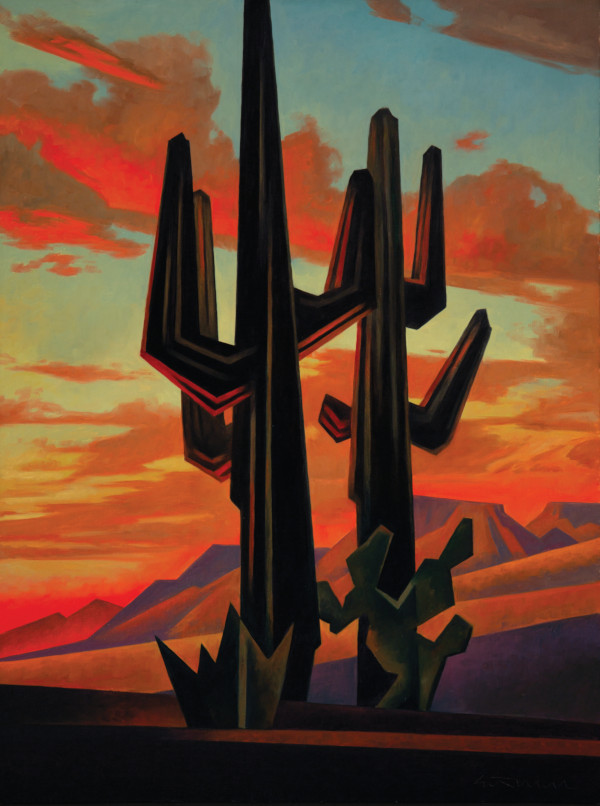
“We flew in a little Hughes 500D jet helicopter … the sportscar of helicopters,” says Mell. Skimming the tops of spectacular rock formations or hovering above terrain virtually inaccessible from the ground gave the artist a unique perspective. “We flew into the Grand Canyon when you could still do that,” he says. “It was hair raising, and there was more than one moment when I thought I was going to die.” The slides he took during these flights remain a visual reference library to which he returns again and again.
Although many of his paintings are clearly inspired by iconic places like the Grand Canyon, the Painted Desert, and Lake Powell, Mell will tell you that he wants to capture the mood rather than an actual depiction of a place. “Think of driving through an area like Monument Valley,” he says. “Later … you won’t remember details, but you will have a lasting impression of the forms, colors, and, especially, the mood.”
Mell describes his painting style as “desert modernism, not cubism but with cubism’s straight lines to add strength to my paintings.” He paints in two different and very distinct styles — both influenced by his commercial art and illustration background. One is expressive realism, which, he says, is serene, poetic, and conveys both the reality and the romance of the landscape. One of his favorite examples, Sweeping Clouds, is in the permanent collection of the Phoenix Art Museum. In his abstract work, the simplified, bare-bones, devoid-of-details style is apparent in works like Cloud Lightning, in which the stark terrain and angular cloudscapes virtually crackle with restless, pent-up energy. He alternates between the expressive realism and abstraction as mood and inspiration strike him. “An artist has to keep himself entertained,” he says. “If he is bored with his work, it shows.”
In the 1980s, inspired by a garden-center purchase of pink gladiolas, Mell began painting flowers. His floral images — petunias, roses, and especially desert cactus blooms — are bold and muscular. He changes his palette and his perspective when he paints what he calls “flowerscapes.” And, indeed, some are colossal like his landscapes, but each flower is endowed with a whisper of tenderness, a luminescence, a transparency. “I think one of the things that fascinates me most is the translucence of the petals, and I enjoy playing with the light coming through,” he says.
He’s quick to point out that he doesn’t just paint landscapes, although that’s what he’s best known for. He also paints familiar ranching scenes — lean-hipped cowboys, wild horses, cattle drives, bucking broncos, and big-and-solid longhorns standing as still as marble statues. “Arizona Longhorn is a portrait of a cow that belonged to a friend of mine,” says Mell. “I wanted to show the strong physicality of the animal against the landscape that’s small and seemingly insignificant and far in the background.” Some of his Western scenes embody the modernist look characteristic of Works Progress Administration murals; others have a bold, almost-cartoonish style typical of Pop Art.
Eager to experiment in other media, Mell started making sculptures in the mid-1980s. “When you’re tired of a two-dimensional surface, it is really nice to grab a piece of clay and see what you can do with it,” he says, adding that, unlike marble, clay is forgiving and easy to work. “You can play with it until you get it right and it is ready to be cast in bronze.”
Mell brings his painting style, with its emphasis on design and stylization, to his sculpture. Strong, straight lines give his sculptures the illusion of speed and energy. Perhaps his most famous is a large-scale public sculpture, Jack Knife, of a rodeo cowboy on a bucking horse that stands at the intersection of Marshall Way and Main Street in Scottsdale’s Art District.
Today, Mell’s art work is collected by celebrities like Diane Keaton and Arnold Schwarzenegger, as well as exhibited or in the permanent collections of many museums, including the Phoenix Art Museum, Booth Museum, Scottsdale Museum of Contemporary Art, and Eiteljorg Museum of American Indians and Western Art, among many others.
Outside the studio, the artist pursues his other passion — automobiles. “It is the art of the car as much as the performance that interests me,” says the classic car buff, who owns a half-dozen vintage models. “I’ve always loved the design of automobiles, and dreamed of being a car designer when I was a kid.”
When we asked him how he’d like to be remembered, after a pause he replied, “As a pretty good painter and a pretty nice guy.”
See more of Ed Mell’s beautiful work at saturdayeveningpost.com/edmell.
Irene Rawlings has written for Art and Antiques, Country Living, National Geographic Traveler, and The Wall Street Journal, among other publications, and is the author of four books, including Sisters on the Fly.
This article is featured in the May/June 2022 issue of The Saturday Evening Post. Subscribe to the magazine for more art, inspiring stories, fiction, humor, and features from our archives.
Featured image: Sonoran Skyfires: “There’s something about the desert sky that is magical.” (© Ed Mell)
Become a Saturday Evening Post member and enjoy unlimited access. Subscribe now
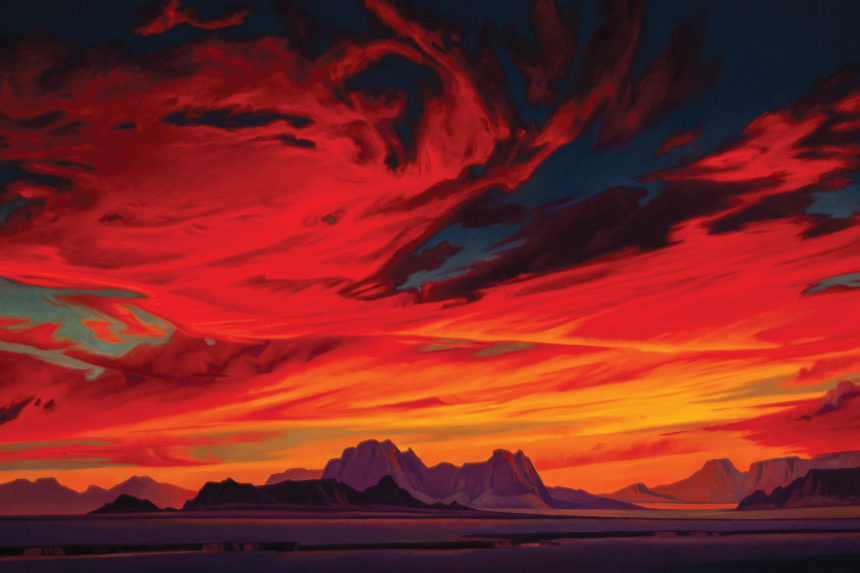


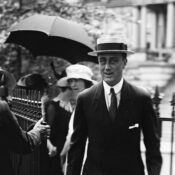
Comments
I should have read this article first instead of the ‘Gallery’ feature, because you talk about the art deco influence in paragraph 6 here! In my earlier comments it was something I strongly ‘noticed’. At least I was right Ms. Rawlings.
Ed Mell’s May/June cactus-at-dusk cover has a mesmerizing beauty that’s otherworldly. Unique; like none ever before it. I like how you go into his thought process in creating his art, basically taking us into his studio, the role the weather plays and so much more. I admire how he keeps his art fresh by reinventing himself as needed.
He’s a classic car guy too. Having 6 real vintage models is wonderful! I just need a lot of money and room. But, 1:18 die-cast models are the next best thing to the real thing. A red ’59 Buick Electra convertible, black ’63 Impala conv., a ’34 Ford coupe. Then there’s the 1:12 scale red ’57 Chevy convertible from the Danbury Mint that does do about everything. $500 in 2004. I had a longer lea$h then, fortunately. We have to be a lot more fiscally responsible now in these dangerous, completely upside down times.